While parkour reimagines the city for artistic or athletic expression, parkour strength training repurposes walls, rails, and stairs into training tools. When you know what to look for, common obstacles at public parks, schools, and plazas can help you get stronger, anytime and anywhere.
Key movements like squat/pull/push, as well as basic parkour skills like jump/vault/climb, enable you to overcome obstacles, literally and metaphorically. Building a stronger athletic foundation with minimalist and highly accessible parkour strength movements is an engaging, effective way to perform better.
Keep going for 10 of my favorite parkour strength movements for beginners (in no particular order):
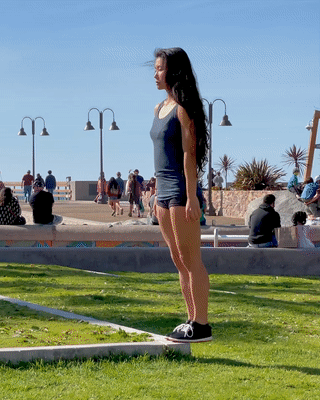

→ To unlock our most comprehensive parkour strength training resource, consider purchasing our digital training manual: Parkour Strength Online
→ For an alternative, skill-based approach to learning and teaching parkour, check out #1 online training program: Parkour 100 Series
Air squat (full ROM)
The full ROM air squat is a fundamental movement pattern to master before seriously drilling squatting/jumping/landing skills of greater intensity and complexity. While a good squat is one key to strong, safe landings, squats are often overlooked because they seem boring or basic.
Honestly, they’re not completely wrong–––especially when compared to flashy flips or jumps. However, you should still practice good squats, now and for the rest of your life. Keep squatting whether you want to perform better in sport, build a booty, mitigate injury, or simply become a badass 100-year-old human who still moves well.
In many cases, squatting to hip-below-knee is good enough but you should also develop your full squat. If you can’t squat this low yet, keep working on your mechanics and mobility until your ROM is greater. Make it a point to constantly improve at this basic squat variation but as you get better/stronger, also experiment with deeper ROM, more explosiveness, single-leg variations, adding weight, and jumping/landing.
- Easier progressions: 1) air squat (upper body assist) 2) box squat 3) air squat (partial ROM)
- Harder: 1) air squat (PL stance) 2) rail squat 3) back squat
Wall dip
Harder than a basic push-up, a wall dip is an upper body strength movement that’s highly specific to parkour. Stronger wall dips will also improve movements like vaults and the second half of a climb-up or muscle-up. If you can easily do 8–10+ wall dips with good form, begin working on more challenging progressions. If you can’t do a wall dip yet, start with something easier.
- Easier progressions: 1) straight-arm wall support 2) bent-arm wall support 3) wall dip (jump-assist + eccentric)
- Harder: 1) weighted dip 2) demon dip (partial ROM) 3) demon dip (full ROM)
Kong-up (split-foot, hip-high)
Kong-ups are useful for building basic strength/power, as well as full-body coordination. Think of it like a more complex box jump, or a 3-dimensional burpee. A kong-up will bring you to a squatting/standing position on top of an obstacle—useful as you transition into a jump or run. Be sure to drill this one with a split-foot stance/takeoff as it will carry over better to kong vaults, climb-ups, etc. (versus a feet-together punching takeoff).
- Easier progressions: 1) ground kong (split-foot) 2) kong-up (split-foot, ankle-high) 3) kong-up (split-foot, knee-high)
- Harder: 1) half-kneeling kong-up (knee-high) 2) half-kneeling kong-up (hip-high) 3) top-out
Knees-to-elbows (dead hang)
Knees-to-elbows from dead hang is a solid full-body exercise with an application to bar skills that require an explosive knees-to-chest tuck. To improve at underbars, pullovers, kips, and laches, you must learn to lift your legs to your torso by using your abs and hip flexors. Also, this general knees-to-chest movement shows up in many more movements like backflips, vaults, and jumps.
- Easier progressions: 1) passive bar hang 2) hanging tuck hold 3) hanging tuck-up
- Harder: 1) knees-thru-elbows 2) toes-to-bar 3) front lever (tuck)
Split squat
The split squat is a key movement for building single-leg strength and mobility. In general, they help strengthen the legs for strides, jumps, sprints, splits, & more. When done through a full ROM, split squats also build mobility in the back leg’s big toe, the back leg’s hip flexors, and the front leg’s ankle/calf.
For all levels, add split squats into warm-ups, workouts, and cool-downs. You may not have access to a full ROM yet, but keep squatting deeper so that you develop more strength *and* greater ROM. As you get stronger, start adding weight!
- Easier progressions: 1) split squat w/ upper body assist (front foot flat + knee-high) 2) split squat (front foot flat + knee-high) 3) split squat (front foot flat + ankle-high)
- Harder: 1) split squat (front foot flat, back foot ankle-high) 2) weighted split squat
Wall handstand (abs-to-wall)
A strong handstand, in general, is a useful tool for building ground/air awareness. As a beginner, you must spend time working on the wall handstand in order to unlock a quality freestanding handstand. For all levels, wall handstands are an effective way to fine-tune handstand technique and build upper body pushing strength.
No need to worry about “perfect” form and alignment, unless your goals are something like elite gymnastics or professional circus. For many athletes, it’s more beneficial to focus on developing adaptability and control across many handstand variations and challenges (e.g. handstand walking, up/down stairs, presses, on walls/rails, etc). Start with the wall handstand, and explore outward from here 🙂
- Easier progressions: 1) front plank 2) front plank (feet knee-high) 3) front plank (feet hip-high)
- Harder: 1) handstand wall walk 2) handstand kick-up + step-down 3) freestanding handstand
Broad jump
Broad jumps are one of the most common power tests in sport/athletics, and a keystone movement skill in parkour. Invaluable for leaping across gaps, broad jumps are also a wonderful exercise for developing full-body power.
Start by standing with your feet shoulder-width apart, and drop into a partial squat while swinging your arms behind you. As you swing your arms forward, explode through your lower body to propel yourself up and forward. Play with different takeoff angles and positions until you find what works best for you.
While airborne, lift your knees to chest and then extend your feet in front of you, reaching for your goal. On flat ground and with padded shoes/surfaces, heel-striking on the landing can be done in a sustainable way and often results in a farther distance. If barefoot and/or jumping on hard surfaces, you may want to reconsider your landing technique to be less heel heavy and more of a precision landing on the balls of feet.
- Easier progressions: 1) air squat 2) vertical jump 3) tuck jump
- Harder: 1) consecutive broad jump (for distance) 2) depth jump for distance 3) drop jump w/ horizontal rebound
Quadrupedal walk
Basic/forward quadrupedal movement is a classic full-body movement for general strength training, as well as a practical movement skill to develop. Moving on all four limbs allows you to pass beneath obstacles too low to run beneath, and it’s also useful for transitioning between the ground and more upright positions.
Start on the ground, supported by your hands and feet, with four points of equal weight distribution. Your butt and head should be around the same height. Advance one hand and the opposite foot at the same time, and then repeat the motion with the other limbs, in a reciprocating pattern.
Be sure to keep some distance between arms and legs so that your knees don’t run into your elbows when you move. Start slow until you get the hang of the forward motion. Then, gradually speed up your movement. For a different but similar challenge, reverse the motion and do it backward. If performing this movement on hands and feet is too difficult at first, find a soft surface (grass, panel mats, etc.) and try it on hands/knees.
- Easier progressions: 1) in-place quadrupedal walk (hands & knees) 2) in-place quadrupedal walk (hands & feet) 3) forward quadrupedal walk (up stairs)
- Harder: 1) forward cat balance (flat ground) 2) forward cat balance (wall) 3) forward cat balance (rail)
Standing box jump + step-down
The standing box jump is one of the most well-known movements in jump training. By jumping onto gradually taller obstacles, you develop general leg power/explosiveness. More specifically, the standing box jump develops vertical jumping power. It also rewards/encourages you to build better squat mobility when pushing your jumps near a max height.
As a quick injury prevention note, beginners should start on low walls and gradually build up the height with greater strength/skill. Beginners should start with a jump up and then gently climb-down/step-down (the rebounding version is higher impact *and* requires more strength/skill).
Even advanced athletes may want to consider this step-down/climb-down element when going through phases of low(er)-impact training. Dropping backward from the top and rebounding back up is much higher impact. It’s also a potentially awkward/unrealistic movement to do at max height. If your skill/strength levels aren’t adequate, or if you’re at risk of overtraining from high(er)-impact activity like sport/competition, rebounding box jumps may be a risky training decision.
- Easier progressions: 1) air squat 2) vertical jump 3) tuck jump
- Harder: 1) standing box jump + climb-down 2) standing box jump (rebounding) 3) running box jump (split-foot takeoff)
Cat hang pull-up
The cat hang pull-up is great for beginners who want a better, faster climb-up. Cat hang pull-ups also build parkour-specific grip strength and footwork. In addition to chin-ups on the bar, most people looking to improve their climb-up, dyno, or 180 should also be doing some kind of cat hang pulling work on a wall.
One common problem people have with the cat hang pull-up is when their hands or feet slip. Ideally, both hands and both feet are glued to pretty much the same spot on the wall throughout each rep. If your hands slip, you might just need to work a bit more on grip strength. If your feet are slipping, you’re probably pushing too hard *down* the wall. Instead, stay tight throughout your legs, core, and arms and apply force straight into the wall through your legs & feet.
If you need another progression before the full cat hang pull-up, try it with a jump-assist and a slow eccentric. When you do CH pull-ups, with a jump assist or not, use as much range of motion as possible so you become strong and skilled throughout all parts of a climb-up.
At the bottom of each rep, go into a full cat hang position with your shoulders relaxed up to your ears. At the top of each rep, pull the wall to your shoulders and lightly touch your chin to the top of the wall. The farther you can reach your chin over the top, the better. However, don’t crane your neck to compensate for not pulling high enough.
Eventually, you will get strong enough to pull-up with a full range of motion and without any jump-assist. Start slow and controlled but as you get better, focus on making your cat hang pulling work more explosive so that you build more power for climb-ups.
Once you can easily do 5-10 cat hang pull-ups for a few sets in a row, experiment with harder variations like doing it slower or faster, using walls with less grip, weighted, w/ lock-off holds, 1 arm, etc.
- Easier progressions: 1) cat hang pull-up (footholds + overgrip) 2) cat hang pull-up (jump-assist + eccentric) 3) cat hang pull-up (overgrip)
- Harder: 1) cat hang knee drive 2) cat hang dyno 3) climb-up (level 3)
Ryan Ford is founder of Apex School of Movement, director of Parkour Strength Online, & author of Parkour Strength Training.
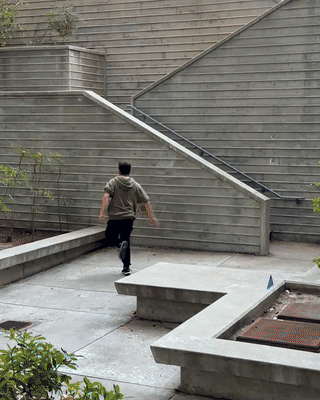
Stay connected
Subscribe for exclusive Apex insights & offers straight to your inbox.
Related posts
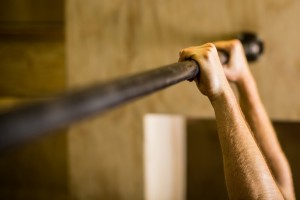
Too old, too fat, too weak for parkour? Start with these 5 basic movements
“When did you start parkour?” “When did you stop?” … 🤔 Everyone did at least a bit of parkour as a kid. At one point

Top 10 bodyweight exercises for intermediate parkour athletes
In parkour, athletes learn to turn the world into a playground. But they should also learn to use common objects like trees, rails, benches, and walls
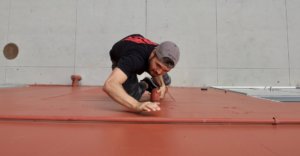
Intro to climb-up strength & skill training
When was the last time you stumbled across a set of rings or monkey bars outside the gym? Maybe at a park or playground? What
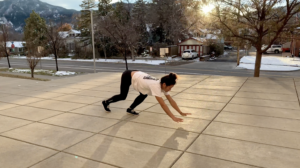
Build your climb-up from the ground up
If your climb-up needs work, consider drilling the progressions in this blog post. For most of these movements, remember to put extra emphasis on training

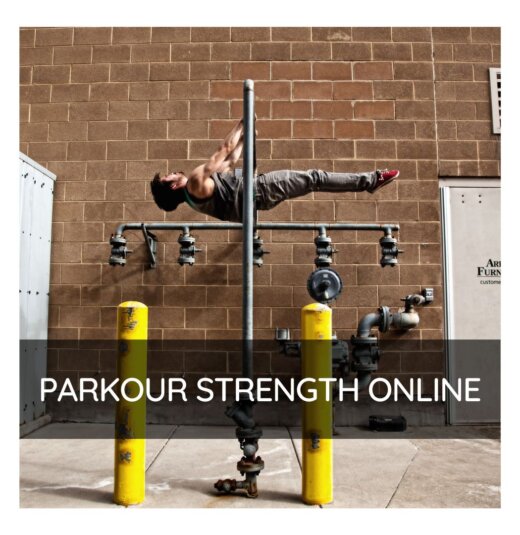
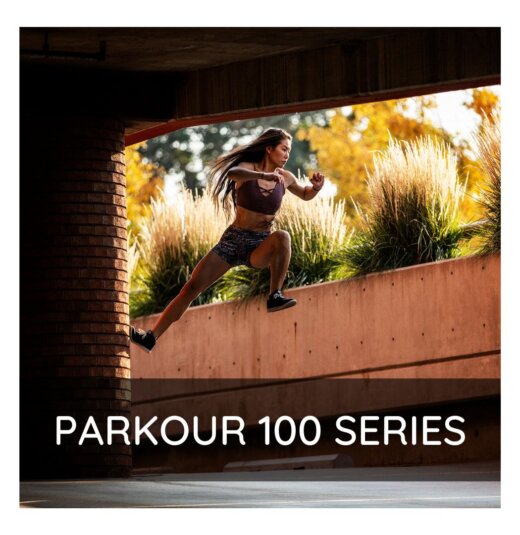
7 thoughts on “Parkour strength training for beginners”
These exercises are amazing love it
Thank you so much
Nicely deconstructed for clean, neat body development.
I love that these exercises are not only awesome, but that you give the rationale behind why they are awesome.
Also – great progressions and regressions. As is to be expected I imagine, I find can do the harder progressions on some, and need to do the easier one on others. In light of this, can I ask you to comment on how you would recommend one should go about programming these?
Cheerio!
Glad you liked it. Programming is such a complex topic because it depends on a lot of things like your own personal strengths, weaknesses, goals, schedule, etc. I dedicated a full chapter to the topic in my book Parkour Strength Training. I also help people out via online coaching/programming or Skype consults. If you want more info, email me at ryan@parkouredu.org
Thanks great help! One thing to inform you is that some progression video links are taking to private videos on youtube and therefore not accessible.
wow, I didn’t realize how many links were out of date here! thanks for letting me know. 1 downside of posting so many new videos is we also need to go back and update blog posts like this anyway, I just went through and updated everything so this article is much better now!